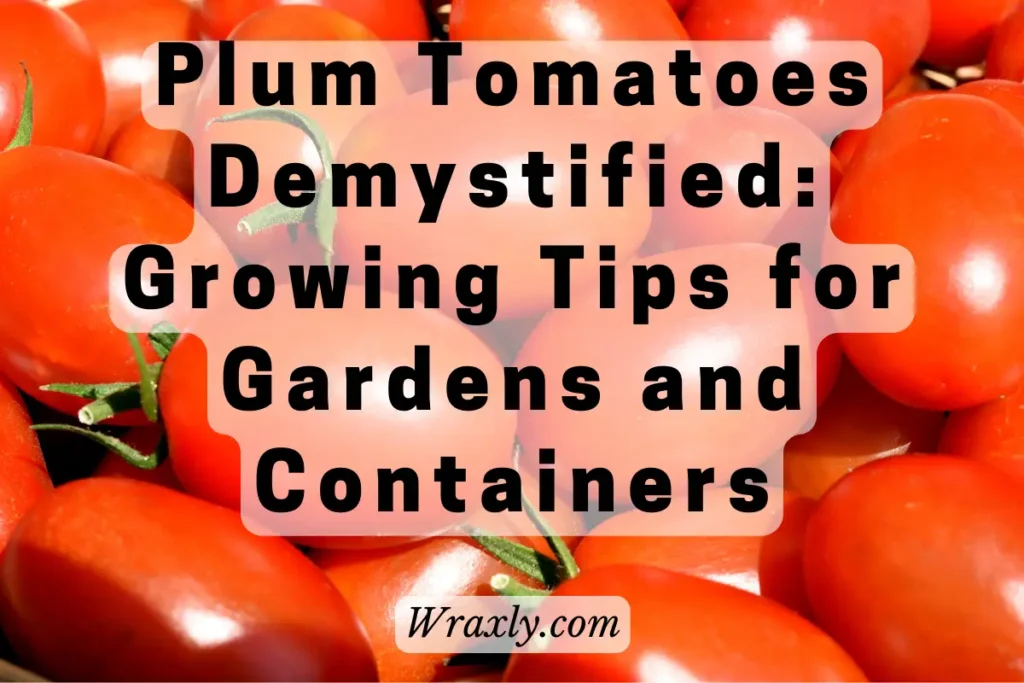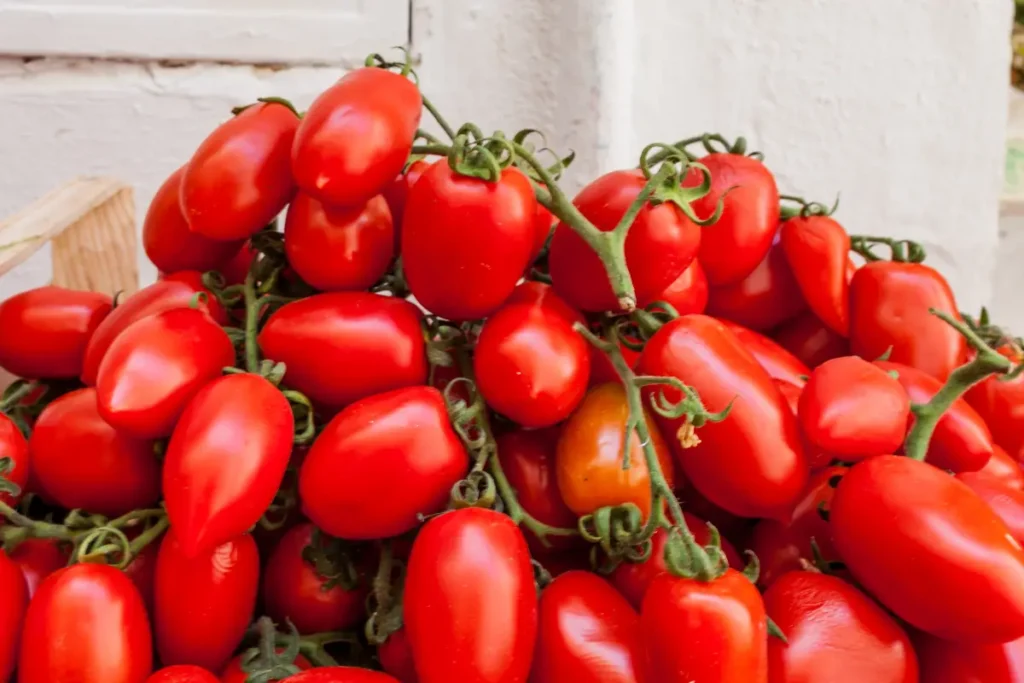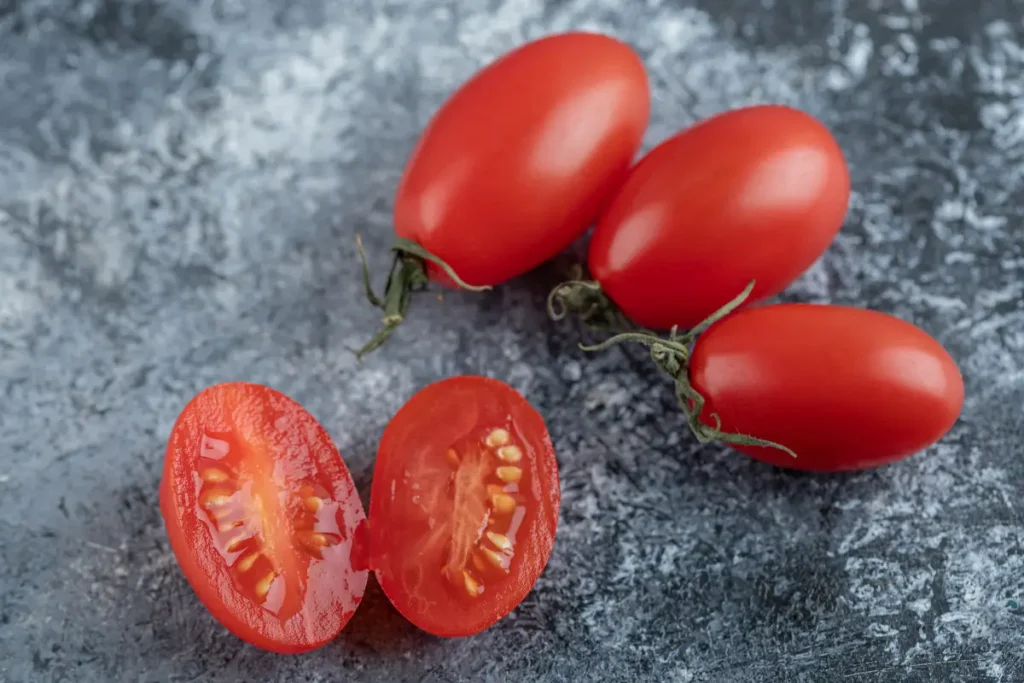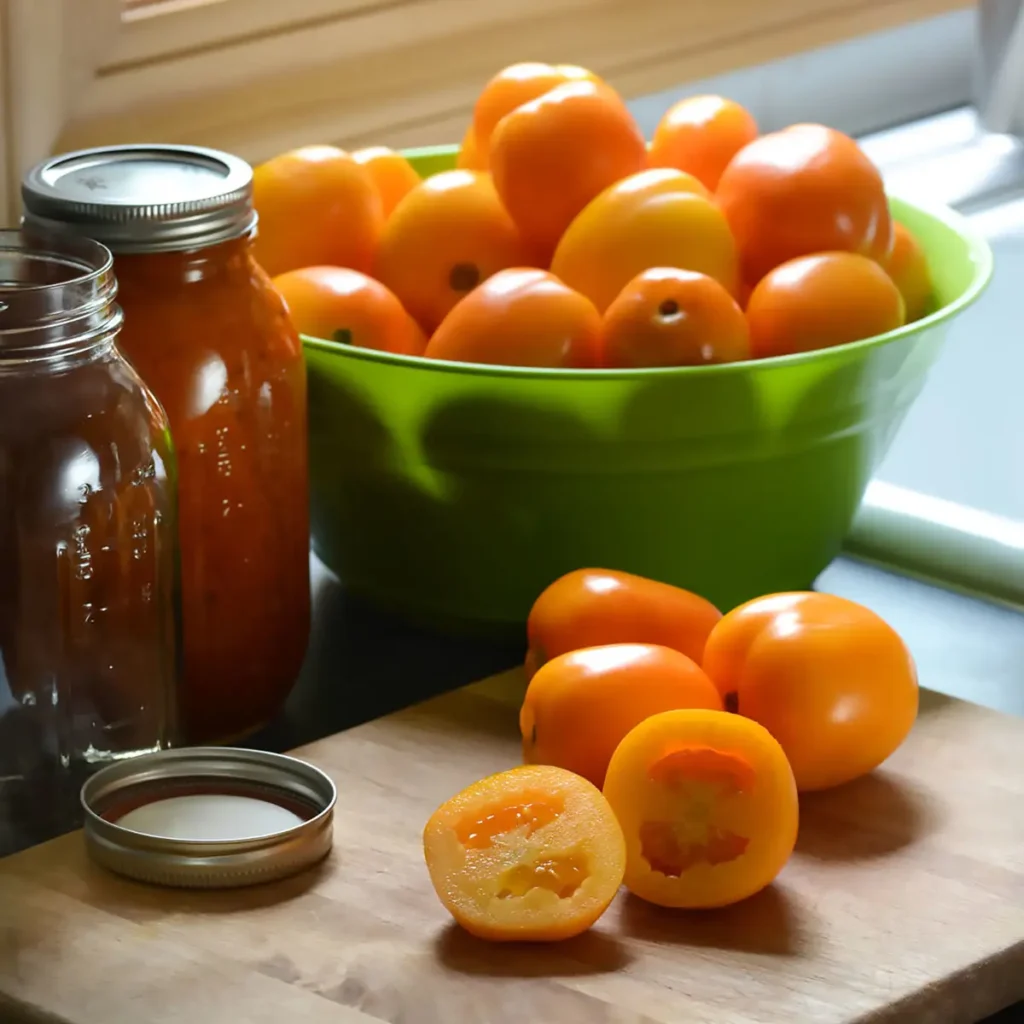Plum tomatoes, renowned for their sweet-acid flavor and meaty texture, are the secret ingredient to a perfect homemade tomato sauce. In this guide, I’ll share with you the essential steps and tips on planting, growing, and harvesting these wonderful tomatoes.
Whether you have a spacious garden or just a small balcony, I’ll help you navigate through choosing the right variety, understanding the optimal growing conditions, and implementing the best care practices to ensure a bountiful harvest of delicious plum tomatoes.

Characteristics of Plum Tomatoes
Plum tomatoes are distinct and highly valued for their unique characteristics, which make them a favorite among gardeners and chefs alike. Here’s a closer look at what sets them apart:
Shape and Size
Plum tomatoes are typically recognized by their elongated, oval, or cylindrical shape, longer from stem to tip than they are wide. They can vary in size; mini plum or grape tomato varieties average 1-2 inches long, while the largest ones mature at 5 inches or more in length.
Flavor Profile
The flavor of plum tomatoes is deep and rich, marked by a sweet-acid balance that is enhanced when heated. Their flesh remains firm even when fully ripe, making them ideal for cooking.
Culinary Uses
Plum tomatoes are versatile in the kitchen. Their reduced liquid pulp and meaty texture make them ideal for sauces, canning, and cooking. Here are some culinary applications of plum tomatoes:
- Eating Fresh: They can be enjoyed fresh as a snack or on a relish tray.
- Salads: Quartered plum tomatoes add flavor and texture to salads.
- Sandwiches: Sliced plum tomatoes can be used in sandwiches for a burst of flavor.
- Fresh Salsas: Diced plum tomatoes are excellent in fresh salsas.
- Sun-dried Tomatoes: Halved plum tomatoes can be dried to make sundried tomatoes.
- Cooked Dishes: They can be incorporated in omelets, stir-fries, and other vegetable dishes.

Varieties of Plum Tomatoes
Several varieties of plum tomatoes are available, each with its unique characteristics:
- Roma: Roma tomatoes are one of the most popular and versatile varieties, known for their resistance to fusarium and verticillium wilt.
- San Marzano: Celebrated for making authentic Neapolitan pizza and pasta sauces, San Marzano tomatoes have a slender shape and full flavor.
- Amish Paste: An heirloom variety, Amish Paste tomatoes are long, with a rich flavor, suitable for sauces, salads, and salsas.
- Sunrise Sauce: This variety is known for its sweet flavor and bright gold, plum-shaped fruits, making it a great choice for sauces.
- Others: Varieties like Orange Banana, Speckled Roman, and Ukrainian Purple offer more options for different flavors, colors, and uses.
Planting Plum Tomatoes
Planting plum tomatoes requires careful consideration of the variety, meticulous preparation of seeds, and attentive transplanting of seedlings. Here’s a comprehensive guide to help you through each step of the process:
Choosing the Right Variety
Selecting the right variety of plum tomatoes is crucial. Consider your culinary needs, available space, and climate when making your choice. Varieties like Roma and San Marzano are versatile and widely used, while others like Sunrise Sauce offer unique flavors and colors. Read the descriptions of each variety carefully to ensure it meets your specific requirements.

Starting from Seeds
- Indoor Sowing: Start seeds indoors 6 to 8 weeks before the last expected spring frost. This gives the seedlings ample time to develop before transplanting. Use cell packs or trays and place them in a location with sufficient light, such as a southern-facing window or under grow lights, to prevent the seedlings from becoming leggy.
- Seed Starting Mix: Plant seeds in a high-quality seed starting mix. This mix usually contains a balanced blend of ingredients that promote seed germination and seedling growth. Keep the soil lightly moist but not soggy, and avoid compacting it to allow for proper air circulation and root development.
- Lighting and Watering Needs: Provide the seedlings with 8 to 10 hours of light each day. Regularly check the moisture levels in the soil and water lightly when the top inch of the soil feels dry. Avoid overwatering as it can lead to root rot and other fungal diseases.
Transplanting Seedlings
- Hardening Off Process: Before transplanting, acclimate the seedlings to outdoor conditions over 4 to 5 days, gradually increasing their exposure to sunlight and wind. This process, known as hardening off, helps the plants adjust to the external environment and reduces transplant shock.
- Planting Depth: When transplanting, plant the seedlings deeply, burying approximately two-thirds of the stem. This encourages the development of a robust root system, making the plants more resilient to environmental stress.
- Soil Preparation: Prepare the soil by amending it with organic matter such as compost or aged manure. This improves soil fertility, drainage, and structure. Also, consider adding a granular organic vegetable fertilizer to provide essential nutrients to the plants.

Growing Plum Tomatoes in Containers
When growing plum tomatoes in containers, select large pots with adequate drainage holes. Larger containers retain moisture longer, reducing the frequency of watering. Ensure the container is spacious enough to accommodate the mature size of the plant and its root system.
Use a high-quality potting mix combined with one-third Kompost or aged manure for container planting. This mix provides the necessary nutrients and ensures good water retention and drainage. Additionally, incorporate a slow-release organic vegetable fertilizer to supply steady nutrients to the plants.
Empfohlene Düngemittel
| Bild | Titel | Prime | Besorgen |
|---|---|---|---|
 Spitze
Spitze | Tomato-tone Organischer Dünger – FÜR ALLE IHRE TOMATEN, 4-Pfund-Beutel | PrimeGeeignet | Überprüfen Sie den Preis auf Amazon |
Spitze Spitze
Spitze | Dr. Earth Organic 5 Tomaten-, Gemüse- und Kräuterdünger Polybeutel | PrimeGeeignet | Überprüfen Sie den Preis auf Amazon |
 Spitze
Spitze | Neptune's Harvest Tomaten- und Gemüsedünger 2-4-2, 36 oz | PrimeGeeignet | Überprüfen Sie den Preis auf Amazon |
 Spitze
Spitze | Ludicrous Nutrients Big Ass Tomaten Premium Gartendünger Nährstoffe drinnen oder draußen funktioniert mit allen Gemüsen, Pflanzen (1,5 lbs) | PrimeGeeignet | Überprüfen Sie den Preis auf Amazon |
 Spitze
Spitze | Espoma Tomate! Flüssige Pflanzennahrung, natürliche und biologische Tomaten- und Gemüsenahrung, 18 fl oz, 2er-Pack | PrimeGeeignet | Überprüfen Sie den Preis auf Amazon |
 Spitze
Spitze | Tomatendünger von EZ-gro ist ein Dünger mit hohem Kaliumgehalt für Ihre Tomatenpflanzen | Feldgetestete Tomatenpflanzennahrung für Gemüse | Ein konzentrierter flüssiger Tomatenpflanzendünger | 1 Viertel | PrimeGeeignet | Überprüfen Sie den Preis auf Amazon |
Container plants generally require more frequent watering compared to garden plants. Keep the soil lightly moist, watering it when the top two inches feel dry. Avoid letting the containers dry out completely, as inconsistent moisture can lead to issues like blossom end rot. Fertilize container plants regularly with a diluted liquid organic fertilizer to maintain nutrient levels.
Staking and Supporting Plum Tomatoes
Supporting plum tomato plants is crucial as it helps in maintaining plant structure, promoting air circulation, and reducing the risk of diseases. It also makes the care and harvest of tomatoes easier, preventing the fruits from touching the ground, which can lead to rot and pest infestation. Here are some ways:
- Cages: Tomato cages are a convenient method, especially for determinate varieties. However, standard cages may not be sturdy enough for vigorous plants, and using heavy-duty cages is recommended to provide adequate support.
- Stakes: Staking is a reliable method, using 1 by 2 inch by 8-foot pieces of untreated lumber to support the plants. As the plants grow, tying the new growth to the stake every week with garden twine is essential to keep them upright.
- Trellises: Trellises, made from wire mesh panels or other materials, offer sturdy support for indeterminate plum tomatoes. They require tying the new growth to the trellis every week in summer, ensuring that the plants remain supported as they grow.
Empfohlene Tomatenstützen
| Bild | Titel | Prime | Besorgen |
|---|---|---|---|
Spitze | Esbaybulbs Pflanzenstützkäfige, Tomatenpfahl, 1,2 m, multifunktionales Gartengitter für Kletterpflanzen, Weinreben, Blumen, Gemüse und Topfpflanzen, 2er-Pack | PrimeGeeignet | Überprüfen Sie den Preis auf Amazon |
 | 4er-Pack Gartenpflanzen-Stütz-Tomatenkäfig, Upgrade 24-Zoll-Spalier für Kletterpflanzen, Pflanzen-Spalier-Sets mit 4 selbstbewässernden Spikes und 20 Pflanzenklammern (24 Zoll) | PrimeGeeignet | Überprüfen Sie den Preis auf Amazon |
 | Hydrofarm GCTR 10 Gal Tomato Garden Planting Grow System mit 4-Fuß-Gitterrädern für Kletterpflanzen und Blumen im Innen- und Außenbereich, Baumturm, grün | PrimeGeeignet | Überprüfen Sie den Preis auf Amazon |
 | Tomatenkäfige für den Garten, 2 Packungen, 122 cm, Pflanzenstütze, Tomatenspalier für Kletterpflanzen im Innen- und Außenbereich, mit 18 einziehbaren Stahlkern-Pflanzstäben und 6 formverstellbaren Ringen | PrimeGeeignet | Überprüfen Sie den Preis auf Amazon |
Harvesting Plum Tomatoes
Ripe tomatoes exhibit their mature color and have a firm but slightly giving texture. They should come off the stems with a gentle tug, indicating their readiness for harvest.
Use garden snips to harvest plum tomatoes to avoid damaging the cluster and knocking off still-green tomatoes. Trying to pull the ripe fruits from the plant can lead to damage, so a gentle snip is preferred to maintain the integrity of both the fruit and the plant.
Determinate varieties ripen around the same time, making them suitable for batch processing like sauces or canning. Indeterminate varieties, on the other hand, produce a steady crop of tomatoes until frost, allowing for a continuous harvest throughout the season.
Bonus Tips
- Choose a Large Pot: Tomatoes need ample space for their root systems. A 5-gallon bucket is ideal. Avoid black containers as they can overheat the roots, and opt for plastic or fiberglass over clay as they retain moisture better.
- Ensure Good Drainage: Proper drainage is crucial to avoid overly soggy roots. If using a bucket, drill holes in the bottom for water drainage.
- Use Quality Potting Soil: Avoid garden soil as it may contain diseases. Use a light, fluffy potting mix that allows roots to grow freely and aids in moisture and air penetration.
- Group Containers Together: This provides some shade for the roots and aids in easier watering.
- Plant Deeply: Planting tomato seedlings deep encourages a strong root system. Remove the bottom sets of leaves and bury most of the plant in the soil.
- Provide Support: Both determinate and indeterminate tomatoes need support structures to handle the weight of the fruit. Add support when planting to avoid disturbing growing roots later.
- Mulch the Topsoil: A 1-inch layer of mulch like straw or shredded bark helps in retaining soil moisture and prevents it from absorbing too much heat.
- Place in a Sunny, Warm Location: Tomatoes require 6 to 8 hours of sun per day. If temperatures drop below 50 degrees or soar above 90 degrees, take measures to protect the plants.
Zum Weiterlesen
- Pflanzen Sie Gurken und Tomaten nicht zusammen: Hier ist der Grund
- Entdecken Sie das Geheimnis für den Anbau köstlicherer Tomaten
- The Secret to a Pest-Free Garden: Plant These with Your Tomatoes
- Wie man hydroponische Tomaten meistert
Final Thoughts on Plum Tomatoes
Growing plum tomatoes involves careful selection of varieties, meticulous planting, consistent care, and proper harvesting. From choosing the right variety and providing optimal growing conditions to implementing proper support and maintenance practices, each step is crucial in cultivating these flavorful tomatoes successfully.
Each type has unique characteristics and flavors to offer, and experimenting with them can lead to delightful discoveries. So, delve into the world of plum tomatoes, try different varieties, and savor the diverse flavors they bring to your table!

Darrell hat eine Leidenschaft für die Gartenarbeit, die er von seinem Vater geerbt hat. Gehen Hier um mehr über den Einfluss seines Vaters auf seine Liebe zur Gartenarbeit zu lesen. Wenn Sie Darrell eine kurze Nachricht senden möchten, besuchen Sie uns seine Kontaktseite hier.

![Zimmerpflanzen gießen [Pflanzenpflege 101]](https://wraxly.com/wp-content/uploads/2021/03/How-to-Water-Indoor-Plants-Plant-Care-101-1200-1024x576.webp)

![Pflanzen aus Stecklingen züchten [Eine einfache Anleitung]](https://wraxly.com/wp-content/uploads/2021/03/Growing-Plants-from-Cuttings-A-Simple-Guide-1200-1024x576.webp)